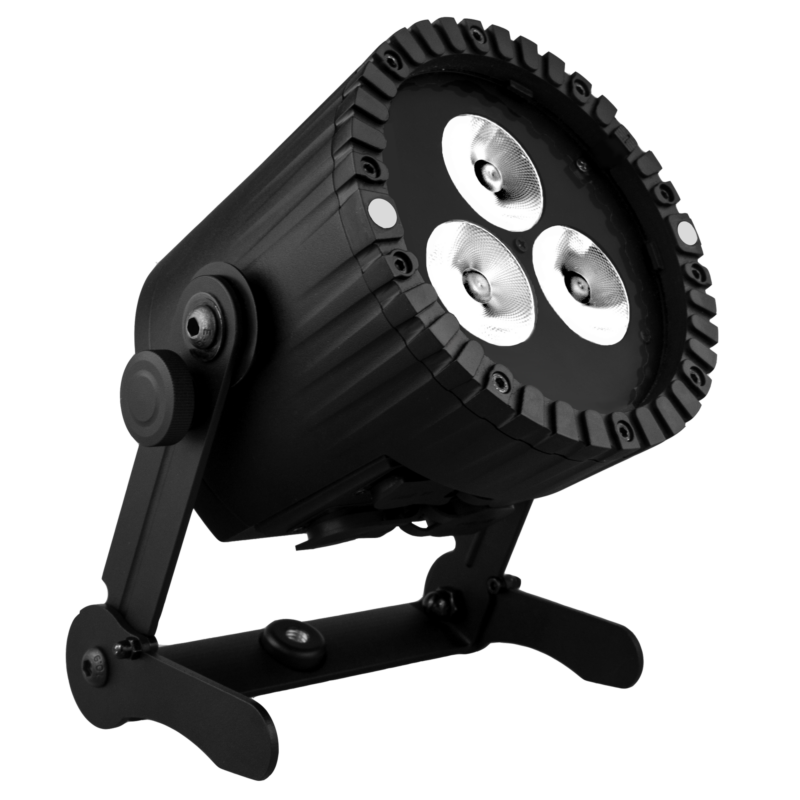Please note that due to a component shortage, we had to do internal changes to AX5 TriplePAR and units manufactured after September 2022, they have the BTB feature built-in and are now called AX5-BTB.
Order Code | AX5 | AX5-BTB |
|---|---|---|
LED Engine | RGBAW | RGBAW |
Colors | RGBAW | RGBAW |
Total LED Power | 45 W | 45 W |
Luminous Flux 3200K | 1 080 Lumens | 1 080 Lumens |
Luminous Flux 5500K | 1 413 Lumens | 1 413 Lumens |
Light Output 3200 K @ 2m | 4 800 Lux | 4 800 Lux |
Light Output 5500 K @ 2m | 5 151 Lux | 5 151 Lux |
CRI (Ra)/ TLCI 3200- 6500 K | ≤92 | ≤92 |
Beam Angle | 13° | 13° |
Field Angle | 26° | 26° |
Strobe | 0 – 25 Hertz | 0 – 25 Hertz |
Pixels | 1 | 1 |
Battery Runtime | up to 20 hours | up to 20 hours |
Battery Lifetime | 70 % after 300 cycles | 70 % after 300 cycles |
Charging Time (nominal) | 5 hours | 5 hours |
AC Input | 90-264 VAC, 47/63 Hertz, 1.2 A / 115 VAC, 1.0 A / 230 VAC | 90-264 VAC, 47/63 Hertz, 1.2 A / 115 VAC, 1.0 A / 230 VAC |
AC Connector | PowerCON TRUE1 IN/OUT | PowerCON TRUE1 IN/OUT |
Wired DMX | Yes (via 5-pin XLR) | Yes (via 5-pin XLR) |
CRMX Receiver | Built-in | Built-in |
BluetoothBridge BTB | No | Built-in |
Wireless Protocols | CRMX, UHF | CRMX, UHF, Bluetooth, Wifi |
Wireless Range | CRMX/UHF up to 300 m / 330 yds | CRMX/UHF up to 300 m / 330 yds Bluetooth up to 3 m / 3.3 yds |
Infrared Control | Yes | Yes |
Housing Material | Aluminium | Aluminium |
IP Rating | IP65 | IP65 |
Ambient Operating Temperature | 0 – 40 °C / 32 – 104 °F | 0 – 40 °C / 32 – 104 °F |
Weight | 3.4 kg / 7.5 lbs | 3.4 kg / 7.5 lbs |
Dimensions with bracket (L x W x D) | 148.1 mm x 193.6 mm x 213.5 mm / 5.83" x 7.62" x 8.40" | 148.1 mm x 193.6 mm x 213.5 mm / 5.83" x 7.62" x 8.40" |
Dimensions without bracket (Ø x H) | Ø 153.2 mm x 140.5 mm / Ø 6.03" x 5.53" | Ø 153.2 mm x 140.5 mm / Ø 6.03" x 5.53" |
Mounting Options | 4x M6 threads, Safety eyelet, Bracket (with 3/8"-16UNC / 1/2" hole) | 4x M6 threads, Safety eyelet, Bracket (with 3/8"-16UNC / 1/2" hole) |
All specifications provided are typical values and may be subject to change without prior notice.
